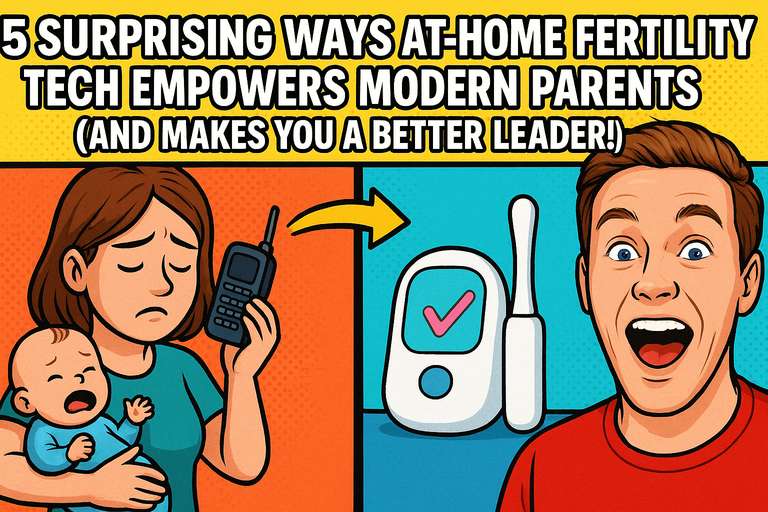Could AI Actually Help You Get Pregnant? The Surprising Truth Behind the Latest Fertility Breakthrough
Imagine hearing this from your doctor: “With a little help from AI, we’re ready to try something that’s never been done before.”
If you’re on any kind of fertility journey—whether you’re just starting to think about parenthood or knee-deep in research about ovulation trackers and supplements—this headline from Time probably stopped you in your tracks: Doctors Report the First Pregnancy Using a New AI Procedure. The TL;DR? Artificial intelligence was used to help a couple get pregnant despite a major hurdle: azoospermia, one of the most challenging forms of male infertility.
But let's back up a second. For years, AI has been the buzzword everywhere: self-driving cars, ChatGPT writing your emails, even making playlists that understand your mood. But the idea that AI could help people have babies? That’s strictly 2025-level science fiction—except it’s not fiction anymore.
Wait, How Did AI Help With Infertility?
Here’s the wild part: azoospermia means there are zero sperm in the ejaculate. That’s a huge (and heartbreaking) barrier for couples trying to conceive. Traditional options are limited, stressful, and can get seriously expensive. But in this case, doctors used AI to analyze sperm samples at a microscopic level, identifying rare viable cells that even seasoned embryologists might miss.
And guess what? It worked. After the AI-assisted extraction, the couple got pregnant. That’s not just a personal victory—it’s a massive leap forward for fertility tech and for anyone who’s ever felt like the odds were stacked against them.
Why Should You Care If You’re Not in a Lab?
Here’s the thing: most people still think of fertility treatments as high-tech, high-cost, clinical-only solutions. But the truth? The tech revolution isn’t just happening in big city hospitals and research labs. It’s trickling down, fast, into our everyday lives—and particularly into our homes.
Just look at the explosion in at-home fertility solutions over the last couple years. From ovulation prediction and period tracking apps to advanced insemination kits, the tools to start (or grow) a family are more accessible, affordable, and science-backed than ever.
And with AI now legitimately helping people get pregnant in ways never before possible, it’s not a stretch to imagine these advanced features coming to next-gen at-home kits soon—making all that high-tech magic a whole lot more personal.
The New Wave: At-Home Insemination Tech
If you’ve ever felt overwhelmed by clinical appointments, sky-high IVF costs, or just the awkwardness of the traditional fertility journey (hello, waiting room anxiety), you’re not alone. That’s exactly why a wave of innovative companies have stepped up to the plate—including pioneers like MakeAMom’s insemination kit options.
What makes these kits stand out isn’t just convenience—it’s how they’re using technology (and a lot of empathy) to fill a major gap.
- Specialized solutions: Kits like CryoBaby (for low-volume/frozen sperm) and Impregnator (for low motility sperm) are tailored for unique needs—because one-size-fits-all doesn’t work when it comes to fertility.
- Inclusivity: There’s even a kit designed for individuals with vaginismus or sensitivities, because real life isn’t always textbook.
- Discreet support: Plain packaging, reusable systems, and a focus on affordability prove that technology isn’t just about the hardware; it’s about compassion, too.
- Real success: With an average 67% success rate, these solutions aren’t simply wishful thinking—they’re changing the game for real families.
Open Loop: Will AI Be in Your Next Kit?
Okay, here’s where it gets really interesting. With AI literally achieving what human eyes can’t, it’s only a matter of time before this tech is integrated into more accessible, at-home forms. Imagine a future where a tiny AI-powered microscope in your kit analyzes sperm motility or even recommends the best insemination timing, right from your phone.
Sounds space-age, but let’s be real: A couple years ago, so did “AI helps treat azoospermia.” Tech moves quickly, and the fertility world is catching up—fast.
What If You’re Starting Your Journey Now?
If you’re reading this because you’re actively trying, considering your options, or you just love the idea of tech empowering people to build families, here’s what you need to know:
- New breakthroughs aren’t just for the ultra-wealthy or those living near world-famous clinics.
- The democratization of fertility tech means you have more options, more knowledge, and more agency than ever before.
- Community and information matter just as much as medicine: Whether you find hope in the latest AI milestone or practical help in a thoughtfully designed at-home kit, you’re part of a movement that’s breaking taboos—and opening doors.
Wrapping Up: Are You Ready for the Future of Conceiving?
The big takeaway? Fertility tech isn’t just about cold, clinical progress anymore. It’s about real people, real emotions, and real innovation that meets us where we are.
So whether you’re curious about what comes next or already exploring your options, remember: the tools, hope, and possibility for family-building are growing every single day—with a little help from science, and a lot of heart.
Would you try an AI-powered fertility solution at home if it became available? Or do you think tech should stay out of this space? Share your thoughts below—let’s start the conversation!





